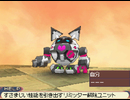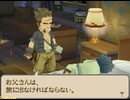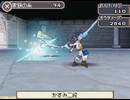|
|

|
PLATFORM
|
DS
|
BATTLE SYSTEM
|

|
INTERACTION
|

|
ORIGINALITY
|

|
STORY
|

|
MUSIC & SOUND
|

|
VISUALS
|

|
CHALLENGE
|
Moderate
|
LANGUAGE BARRIER
|
Variable
|
COMPLETION TIME
|
20-40 Hours
|
|
OVERALL

|
+ Original battle system still shines.
+ Additions to battle system shine more.
+ New content is interesting.
+ Music has been reworked well.
- Story is still sparse.
- A few missed opportunities for expansion.
|
Click here for scoring definitions
|
|
|
I have a long history with SaGa 2: Hihou Densetsu. Eighteen years ago, it was one of the few RPG titles for rent at my local Phar-Mor. Fourteen years ago, it was the first game I bought with my own money (Phar-Mor having closed its rental area by this point). Six years ago, I bought it in Japanese. Last year, its DS remake became a day-one purchase for me and now has eighty hours on the clock. A year ago — and at the time this review is indexed, it will be almost exactly a year since its release — expectations were high that this game would receive an overseas release. I even wrote an impression for it. Obviously, that has yet to happen, so it's up to me to tell everyone what they're missing.
As mentioned above, SaGa2 is a complete remake of the game most foreigners know as Final Fantasy Legend II for the original GameBoy. The main point of this review is to focus on the new aspects of the game, but some groundwork needs to be laid first. Here's what's (largely) the same.
First, there's the storyline. Of all the parts that make up SaGa 2, this has had the fewest changes made to it. In fact, anyone who has played the original will understand exactly what is going on in every major event in the game. This isn't necessarily positive, as the remake shares most of the faults of the original as well. The primary plot is based around the hunt for the main character's father and for a set of mystic artifacts called Magi. Along the way the player must traverse nine worlds, two pocket worldlets, a cloudy afterlife, and the crystalline framework linking them all together. Most character development is on the part of the NPCs who inhabit each world, as the party characters are completely up to the discretion of the player.
The second item left largely unchanged is the player's choice of characters. The nominal main character is chosen at the beginning, and after a few scenes the player will have the chance to round out the party with three more characters. There are four basic types to choose from, each with different strengths and weakenesses.
 Real mechs wear kitty ears.
Real mechs wear kitty ears.
|
|
Humans excel at physical combat: males start with strength-based weapons and females start with agility-based weapons. They gain physical stats and hit points handily, but are at the mercy of their weapons' durability. Espers (also called Mutants) are magically inclined humanoids whose starting elements fall along gender lines. While they don't gain strength or hit points as quickly as Humans, they learn magical attacks which can be recharged with items or by staying at an inn. Humans and Espers also gain skill levels in certain weapon or magic types in this version of the game.
Robots gain stats by equipping armor and weapons. Any weapon they wield is reduced to half its durability, but becomes rechargeable. Their weakness is that they cannot normally gain magical power, which puts them at a disadvantage for healing. One of the biggest changes in the equipment for SaGa 2 is that there's a larger selection of robot-only equipment, specifically components that attract or deflect attention from the enemy, and a set of circuit boards that give the bearer magical ability.
Out of the four types, monsters have always had the most variety. In both versions, the game has thirty-eight clades of monsters (in addition to robotic or humanoid enemies), of which thirty-six provide possible party members. Not counting the three special monsters available at the beginning, there are five monsters per clade for a total of one hundred eighty possible teammates. Monsters can change shape by eating the meat of another monster after battle. In the original this followed an odd bit of programming that made it difficult to tell what results might occur, but in the remake the system's been sorted out better, and a monster index has been added to show transformation results. The weakness of monster types is that while they generally have balanced stats and movesets, they're also set in those configurations without any means of increasing stats at the end of the game. New to this version, monsters may sometimes inherit abilities from a previous form, or change into an alternative version of a monster with ability sets that differ from what's normally seen.
The remake does a better job of making things like the effects of equipment or Magi clearer, but it still misses on a few things. The new skill stats for Humans and Espers are never shown, for example. Healing is still based on the magic power of the healer and the recipient, which is hard on Robots. The monster index helps a lot, but it's not accessible when it's needed most — namely at the end of battle when the player has to decide whether or not to eat the meat.
While the plot is as bare as before, some changes have been made. Major events in the main story often have lines added that flesh out bits of background but don't change the basic facts. Rather than make gross alterations right and left, the developers opted to add a large number of sub-events scattered across the game. Many of these are minor, only adding a treasure point on the map, but others deal with various NPCs after their part in the main story is through.
 Why does he always leave through the window?
Why does he always leave through the window?
|
|
The most important of the sub-events have to do with the Muses, a set of young goddesses encountered in the first half of the game. Winning the trust of these ladies is essential, as they gift the player with Muse Points (MP) after battle. Each Muse gives according to her combat preferences — for example, Kalliope gives MP for finishing a battle quickly, while Polynia rewards massive damage totals. If enough trust is built between the player and a Muse, she'll agree to aid the party in-battle from time to time. These events are unfortunately not too common, but can be lifesavers when they do occur.
Muse Points are more important, as they can be traded to the Moirae, Goddesses of Fate, in exchange for Combo Threads. These items serve two purposes. The first is that they allow characters to link attacks in battle, often skipping over large numbers of enemies in the turn order. Linked attacks are different from normal, as every weapon, spell, or monster attack can spark a stronger ability. Linking more than two attacks in a row can spark even more powerful attacks. Fans of the series should be happy to hear that almost all of SaGa 2's one-hundred-plus sparked moves are references to later games in the series.
Combo Threads come in various flavors of emotion, ranging from friendship, love, or hate to things like competition and cooperation. If two characters are linked a few times in battle by the same thread of emotion, their attitude towards each other will change. The dominant emotion of a team determines its team name, character reactions in sub-events, and even which sub-events will become available.
The last major changes in gameplay happen in the field. Various special Magi enable the use of field abilities similar to those seen in Romancing SaGa - Minstrel Song. Half of them are active, allowing the player to dig for treasure, break weak walls, sneak or dash past enemies, and sundry others. The other half are passive, and generally relate to the game's mini-map feature.
Also new to the game is the switch from random encounters to enemies roaming free on the field, as they do in every post-GB game in the series. With this comes the possibility of several nearby monster sprites in the field linking to attack the player in concert. Normal battles pit the player against up to three groups of monsters, with up to nine monsters in a group. Linked battles can have up to six groups surrounding the party, and up to fifty enemies in total. Fortunately, extra-large battles only occur towards the end of the game when the player should have a good selection of group-hit and hit-all attacks equipped.
 Hit combo for massive damage!
Hit combo for massive damage!
|
|
Seeing as the original was for the GameBoy, graphically this game has nowhere to go but up. Humans and Espers each have four different character models per gender, and Robots have four as well. All models have a choice of color palettes, which makes for some welcome variety if the players opt for a single-type party. While some sets of enemies are straight palette swaps, others vary greatly in appearance, and the major bosses are all amazing to behold. Every town, dungeon, and region in the game has its own distinct character and landmarks that go far beyond what would be necessary. In one perfect example, there's a pocket worldlet about halfway through the game that serves only as the setting for a minor showdown. In the original it was barely anything, but now it's a winding trail through a craggy ravine, with a bridge spanning a massive chasm and a replica of the lost city of Petra at the end.
Kenji Ito's original musical score has been masterfully redone. Many tracks have been reworked with full instrumental accompaniment, but all are recognizable as the same tunes which were so enjoyable in the original. New parts of the game, including the intro sequence and the Muses's world, feature new tracks that include references to the original soundtrack.
In the final analysis, the changes made amount to a new coat of paint, some much-needed tweaking, and bonus content, meaning that much of what the game offers is the same as it was in 1990. The additions to the gameplay make it easier in some aspects, but easier isn't the same as easy. Modern players experiencing this for the first time can expect quite a lot of challenge in this title. A single playthrough can be completed in twenty hours, but with the optional super-battles and side-quests it can take as much as thirty.
SaGa 2 stands as an example of how some games, even after two decades, can be as viable as ever. It's a shame that Square Enix has not seen fit to share it with the rest of the world.
Review Archives
|









